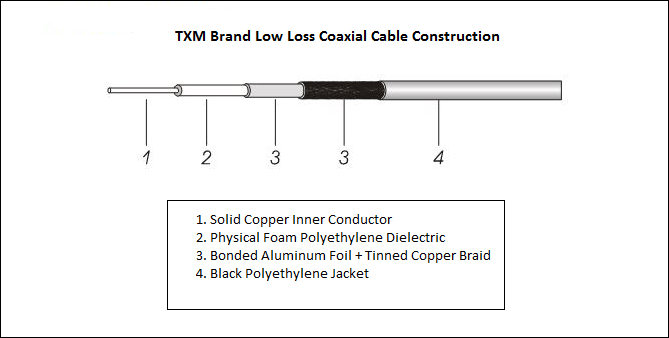Low Loss Coaxial Cable- The Basics
History
Coaxial Cable, patented in 1880 by Oliver Heaviside, was one of the first shielded cable designs in history. Originally invented to combat radio interference, this cable has proven its usefulness by remaining a mainstay in the telecommunications world for over 100 years. RG Coaxial Cable proved very useful in combatting the radio interference, but technology progressed and more radio interference and even electromagnetic interference began to overcome the older designs of cable. Of course, many revisions have been made to Heaviside’s design over the long life of coaxial cable, with one of the most valuable versions of the wire being Low Loss Coaxial Cable. But what differentiates this cable from standard RG Coaxial Cable?

Low Loss Coaxial Cable
The primary utility of Low Loss cable is the lower rate of attenuation, or degradation of signal strength through the cable. This is achieved by increasing the amount of shielding throughout the length of the cable. While all Low Loss cables have lower attenuation than standard coaxial cable, there are many different sizes of the cable, each with varying degrees of shielding. The number in the designation number for low loss coaxial cable is roughly equivalent to the diameter of the cable, and is a good indicator of the level of shielding and attenuation. For instance the LOW600, the largest cable offered by TXM, has a diameter of .59 inches, with a typical attenuation of 7.45dB/100ft, at a frequency of 6000MHz. However, larger cable is not without trade-offs. The increased shielding and diameter of the cable greatly increases the weight of the cable. Fortunately, Low Loss Cable comes in smaller variants that still manage to have a very low rate of attenuation. The TXM LOW195 is less than a fifth of the weight of the LOW600 cable, while still maintaining a typical attenuation rate of only 28.2dB/100ft at 5800MHz. Of course, there are options in between these two extremes, such as the LOW240 and LOW 400 size Low Loss cables.
- LOW195 equivalent to CNT195, RF195, and LMR-195
- LOW240 equivalent to CNT240, RF240, and LMR-240
- LOW400 equivalent to CNT400, RF400, and LMR-400
- LOW600 equivalent to CNT600, RF600, RFC600, and LMR-600
Visit our website at www.TXMSTORE.com for easy access to instant purchasing, or to request a sample 1 foot length.
We offer same day shipping on all stock items.
Recent Posts
-
Times Microwave’s new LMR Tool Kit
TXM Manufacturing is now offering Times Microwave’s new LMR Tool Kit. This new kit includes all tool …8th Feb 2022 -
Opti-Tap and Opti-Tip Cables
TXM is now offering Opti-Taps and Opti-Tips to our customers. The Opti-Tip and Opti-Tap fiber cable …11th Jan 2022 -
Bus Bars for Telecom rooms
In a typical Data Center, you will often have many different ground bars in use through out the fa …12th Nov 2019

